- Home
- Michael Byrnes
The Sacred Blood Page 12
The Sacred Blood Read online
Page 12
“You all right?” Enoch asked with sincere concern.
“Eh. Been better. Have a few minutes for me?”
“Got a briefing in ten, but let’s hear it.”
Amit made sure to squeeze everything he could into a two-minute recap of last night’s assassination attempt. He mentioned the guy’s tactics: his silencer-equipped Israeli pistol, his knowledge of explosives. Deciding to play it safe, he left Jules out of the story. “Same kind of stuff we used to see in Gaza, if you know what I’m saying,” Amit told Enoch.
After a brief silence with more wind whistling through the receiver, Enoch finally came back with, “Hell, I don’t know what to say. Sounds to me like it has something to do with your excavations.”
“Definitely. The entire site was wiped out.”
An uneasy pause.
Enoch’s reluctance was not subtle. Amit couldn’t blame the guy— Enoch was a family man, and much better at it than himself. This was dangerous stuff that could have serious repercussions for him too. Then came the question Amit was hoping for.
“So how can I help?”
“I know it’s a huge ask—puts you in a very difficult position. But if someone on the inside wants me dead, I need to know.”
“If they want you dead, it won’t matter what you know.”
He had a point. Once you were caught in the agency’s crosshairs, the Mossad wouldn’t let up until a file could be rubber-stamped in red. Should’ve killed him, a tiny voice kept whispering to Amit. Killed him and hid the body. Then he’d at least stand a chance that the guy’s employer would think the job was a success—that Amit and Jules were buried in the rubble. “Just need a fighting chance. If there’s a directive, maybe you can find out about it. See if I’m marked. And if so, why?”
More wind whistling through the receiver.
Enoch groaned. “I’m in Collections now,” he finally replied. “Nowadays, they’ve got me monitoring wire transfers and chatter. So I don’t have clearance for that type of information anymore,” he said in a low, uneasy tone. “But I still know some people in Metsada. You’ve got to give me some time.”
Amit grinned and gave Jules a thumbs-up. “That’s great, Enoch. Really great.”
Of the institute’s eight branches, Metsada was the Mossad’s special operations unit—the coordinators of assassinations and paramilitary and covert operations. Its huge database contained the agency’s most guarded information.
“By the way,” Amit added, “I have something that might help. I took a picture of the guy. I’m no photographer, and I used my phone to take it. Anyway, it should be enough that someone might recognize him. Do you mind if I send it to your phone?”
“Do that. It can’t hurt. I need to get going. I’ll call you as soon as I have something.”
Ending the call, Amit powered on his mobile only long enough to push the pix image over the airwaves to Enoch’s phone. Then he powered it off just in case his hunter tried using it to triangulate his location. “Think he’ll help?” Jules asked as he got back into the Land Rover. “Yeah, I do. Enoch’s a good man.”
“What do we do in the meantime?”
He stroked his goatee. “I think we should take a ride to the Rockefeller Museum. Have a talk with my friend Jozsef Dayan.”
25
******
Rome
“You’re sure this is going to work?” Charlotte asked as the taxi pulled to the curb along Borgo Pio.
“I don’t see why not,” Donovan said. “We’ve come this far . . .” He held up his hands and smiled. After paying the driver 40, he and Charlotte got out of the taxi toting their small travel bags. “It will be fine.”
For some reason, she believed him. Just like she had when she let him talk her into driving to Phoenix Sky Harbor International immediately after they’d stopped at her home to get her passport and some essentials. Donovan had been wary of going to her house because he’d thought the men might have gone directly there after seeing the address on Charlotte’s driver’s license. But she’d informed him that after all that had happened at the Vatican, upon her return to the States she’d immediately switched her physical address to a local Mail Boxes Etc. store. That was the address that appeared on not only her license but all mail and correspondence as well. Conte couldn’t get all the credit for that, though; there were plenty of fanatics out there who put genetics on equal footing with abortion and murder. Some level of anonymity was prudent. However, since she’d left her purse at BMS, Donovan had put the pricey Continental airline tickets on his credit card.
Though the flight hadn’t departed till six a.m., neither of them had slept during the four-and-a-half-hour trip to Newark or the hour-and-ahalf layover there. Plenty of time for Charlotte to shed some more tears while Donovan tried his best to console her. It’d been the smooth eight hours crossing the Atlantic and Western Europe that had done the trick. They’d both woken up when the plane was in its final descent into Fiumicino around eleven a.m. Roman time.
She followed Donovan across the street.
“I’ll need your passport,” he said, and waited for her to retrieve it from her bag. Taking it, he cast his eyes heavenward and said, “Here’s to the luck o’ the Irish. Just give me a few minutes and wait here.”
She stood aside on the busy sidewalk. At the huge, ornate iron gateway crowned with a papal crest and flanked by Roman columns, she watched him approach a Swiss Guard wearing a blue jumpsuit, a sidearm, and a black beret. Over the busy commotion—cars and visitors queued in separate lines—she could barely hear the exchange. Though it didn’t matter, since Donovan seemed to be conversing with the man in Italian. He presented their passports and the guard looked over at her. Next, Donovan produced a badge that was no doubt his outdated Vatican ID. Satisfied, the guard went behind the gate and waved for him to follow. Donovan confidently glanced over at her, smiled, and held up an index finger. Universal for So far so good. I won’t be long.
When the first five minutes had gone by, crazy thoughts came to Charlotte—outlandish suppositions of why Donovan thought it best to come here, of all places. Could this be his elaborate plan to get her back into Vatican City—a trap? Maybe Conte was really alive, waiting behind the gate for Donovan’s instructions to nab her.
But the laptop was more important than she—that’s where the incriminating information really was. That’s when it hit her: My laptop. Christ, what if those men got hold of the files? She took some comfort in knowing that the data was encrypted. Still . . .
Should it be surprising that she hadn’t heard news reports concerning Conte’s death? After all, Donovan had indicated that Conte wasn’t even the mercenary’s real name. And it was just another unsolved murder in Italy. Not prime pickings for CNN. But Santelli’s death? Would that have made news in the U.S.? It’s not like he’d been the Holy Father himself, but he was the Holy See’s equivalent of vice president. Now she was wishing she’d had time to verify Donovan’s story.
“I can’t believe I’m doing this,” she mumbled.
A kind-looking priest was just exiting the gate and walked past Charlotte. Seeing her troubled expression and puffy eyelids, he smiled politely, glanced quickly at her bag, and greeted her with a warm “Hello.” Lucky guess, she thought.
“Hello,” she said, smiling. Then she realized that her duffel bag, a complimentary joiner’s gift from her local YMCA, had the facility’s Phoenix address on it. The window of opportunity hadn’t closed. “Excuse me, Father?”
The man stopped and turned to her.
She took two steps to close the gap. “I know this may sound like an odd question . . .” She rolled her eyes.
“I’m a priest. I get many odd questions, my dear.”
The kind, aged face reminded her of her dad. “It’s quite embarrassing that I don’t know this,” she said, spreading her hands, “but is Cardinal Antonio Santelli still with the Vatican secretariat’s office?”
The man drew his lips tight and somberly sho
ok his head. “Sorry if you haven’t heard. His Eminence passed away some months back.” “Oh.” She feigned distress. “That’s terrible. What happened?” “His heart gave out, I’m afraid. God rest his soul.”
She thanked the priest, and when she turned, Donovan was standing outside the gate waving her over. That’s when she realized it was a beautiful day in Rome—clear skies and mild. And rising up all around her, the Renaissance architecture helped calm her spirit. A big improvement over her last visit. She strode over to him.
“What was that all about?” Donovan asked, curious.
“Oh, nothing,” she said. “Just chatting.”
“You’ll need this,” he said, handing her a laminated badge encoded with numbers, her name, and a high-resolution scan of her passport photo set beneath the flickering hologram of a papal crest. “They’ll hold our passports till we leave. Things have a gotten a bit more strict, I’m afraid.”
She shrugged and clipped the badge to the lapel of her rumpled blazer. “As long as they still have showers in there, I won’t complain.”
Passing through the gate, Donovan led her through the Vatican’s tiny commercial district. As they passed Via dei Pellegrini she looked left, up at the rear face of the Apostolic Palace. W hen her eyes came down again, they were nearing the spot where she’d had a final showdown with Conte. The killer’s final words echoed in her thoughts: “Remember your confidentiality agreement, Dr. Hennesey. Or I’ ll have to come and find you.”
And it was virtually on that very spot that Charlotte noticed a familiarlooking priest awaiting them.
“Patrick! So good to see you!” the priest said.
Donovan embraced the man. “It’s been a while.”
“Too long.”
Donovan turned to Charlotte. “How rude of me. Charlotte, you remember Father James Martin? He was Cardinal Santelli’s assistant?”
The poor man chained to a reception desk outside the cardinal’s office. What she remembered most was the dark circles under his eyes and his pallid complexion, which seemed even worse in daylight. He looked like a creature of the night. “Of course. Good to see you again, Father,” she said, offering a handshake.
He took her hand in his. “Charlotte,” he said, cocking his head sideways as if trying to place her face. But really, hers was not a face to forget. He distinctly remembered—May God forgive my impure thoughts, he prayed— admiring her as she signed confidentiality agreements for Santelli’s secret project; the project that now put his sister and her beautiful family in jeopardy. “Yes, Dr. Charlotte . . . Henry, was it?” He purposely botched the last name to alleviate suspicion. He’d remembered her name yesterday, when he’d immediately called the mobile number his abductors had provided. And only minutes ago, he’d placed a second call to Orlando on a new number, alerting him to the duo’s unexpected arrival.
Her last name was printed in bold, twenty-point Times New Roman on her badge. Maybe he didn’t want to be rude and look down since it was hanging over her left breast? Charlotte wondered. “Close. Hennesey.”
“Sorry, I’m so terrible with names,” he said, some rosy color marbling his pale cheeks.
He finally let her hand free, leaving a damp, cold feeling behind.
“It’s such a pleasure to have you staying with us again. Anything you need during your visit, you just give the word.”
“Thanks so much for your hospitality.”
“You’re very welcome. Well then, let’s get you both situated. You can freshen up, take some time to rest.” He led them up a walkway cutting alongside the Apostolic Palace. “Are you available for lunch?” he asked Donovan. “Take some time to catch up? You too, of course, Charlotte.”
“If it’s all right with you, Charlotte,” Donovan replied.
“Sounds great.”
26
******
Tel Aviv, Israel
“So what do you make of all this?” Cohen asked.
Renowned professor of Israeli population genetics David Friedman leaned back in his chair. His protruding dull eyes were magnified through the lenses of thick bifocals. The gaunt thirtysomething had no hair or eyebrows, the result of an extremely rare disease called alopecia universalis. The complete baldness of his body, coupled with his protruding steel-gray eyes, could make one wonder if he’d been beamed to earth by a flying saucer. His mind-boggling intellect was otherworldly too. But it didn’t negate the fact that the man was socially awkward and irritable. And the fact that he staunchly denounced both God and Judaism was a huge tax on Cohen’s patience.
“There’s a lot of information here, Rabbi,” he said, looking exasperated. “I’m going only by data and pictures, not a specimen. I’d be speculating,” he warned. “And unless I was seeing this with my own eyes through a very powerful microscope . . .” He shrugged. The professor’s gaze wandered to his office window, through which he could see students milling about Tel Aviv University’s palm-treed quad.
“Please.” Cohen opened his hands and beseeched with uncharacteristic finesse. “Speculate.”
Moaning, Friedman circled his gaze back to the monitor at the plot of forty-eight chromosome pairs. He shook his head and said, “All right then. First off, I study the human genome. And this? This is too small to have come from a human.”
“How so?”
It had taken till midnight for Cohen to identify nine telling files that had been on Charlotte Hennesey’s laptop. Ziv had copied them onto a flash drive now sticking out of a port on Friedman’s juiced-up Macintosh. All nine files were running on multiple windows layered on the professor’s oversize plasma.
Friedman clicked a tab on the bottom toolbar, and a data file maximized to fill the screen. “See here,” Friedman explained, pointing to the different combinations and sequences of A, C, G, and T—each letter was assigned a different color. Running above them was a continuous series of vertical lines in varying thicknesses that resembled a bar code spread out to infinity. “You know how many base pairs we’d expect to find in the human genome?” The question was rhetorical. Aaron Cohen was an excellent study and could easily find a second career in Friedman’s lab.
“Three billion.”
“And what do you see here?”
On the monitor, next to a field labeled base pairs, was a number: 298,825,111.
“I understand it seems too small. But what if this is from a human specimen?”
“It’s not, Rabbi. I assure you. Look at this . . .” His growing frustration made his bony shoulders twitch as he brought another active window into full-screen view. Feeling like a doctor whose patient wouldn’t accept a cut-and-dried diagnosis, he said, “Here, use those good eyes of yours, Rabbi—the scientific ones. Check your mysticism at the door.” Friedman pointed to the video showing fluoresced chromosomes being extracted with a needle from a cell nucleus. “If this was real . . .” He shook his head again. “This looks like science fiction to me. Watch what happens here.” He waited. “Ah. There. See it? This pair of chromosomes here?”
The rabbi drew close. “Yes.”
“These two chromosomes are instantly replacing extracted genetic material. Rebuilding the genome.”
“Is that not possible?”
“On earth? Impossible.”
“So how do you explain this?”
The professor threw his hands up. “A computer-generated simulation. Hollywood. Who knows? I’m sorry to say that I think you’ve been duped.” Despite his harsh incredulity, the rabbi was not at all discouraged. In fact, he seemed quite pleased. Perhaps the professor himself was being duped? “Does this have something to do with the Cohen Gene project? Is someone making you empty promises? Or are you just testing me?”
“I’d be speculating,” the rabbi noncommittally replied. This actually wrenched a chuckle out of the cantankerous brainiac. “So there’s no way to tell from this if it’s real?” he persisted.
“Get a sample. Then I’ll tell you if it’s real—and which planet it comes from.”
Cohen smirked. “Bring up the other image,” he insisted. “The one with the two chromosome plots side by side.”
Luckily, Charlotte Hennesey’s file-naming system was descriptive. This one was named “karytope.subjectA-henneseyB.” And Ziv had easily discerned from the file’s attributes that this had been the last file running on the geneticist’s laptop prior to its recovery in Phoenix.
Friedman switched windows.
“If I were to bring a sample to you— from Hollywood,” the rabbi said, keeping it light to hold Friedman’s tiny suspicions at bay, “which sample would you need? The one on the left, or the one on the right?” Not that he’d dare share such a thing.
With little enthusiasm, the professor played along with the charade. “This one labeled ‘subject’ is hypothetically from a male,” he said. “And this one here is obviously female, this one labeled ‘Hennesey,’ whatever that means. They seem identical, give or take the sex chromosomes, of course. In this fantasy world, it’s this chromosome set here that really matters. For fun, let’s call these two the ‘builders.’ Easy to spot because it doesn’t even look like a human chromosome.” He tapped twice on the monitor— first on subject’s unbanded chromosome pair, then on Hennesey’s identical pair. “So since the builders can single-handedly manufacture all the other chromosomes in the genome, I’d say that’s where the magic is. Your Hollywood starlet,” he joked. “And hypothetically speaking, since the builder chromosomes are present in both your male and female specimens, either sample would suffice.” He shrugged.

 The Sacred Bones
The Sacred Bones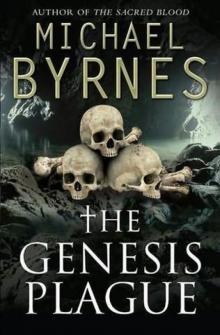 The Genesis Plague (2010)
The Genesis Plague (2010)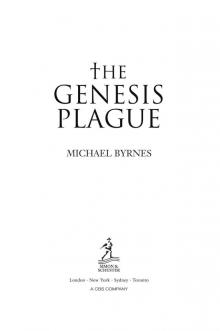 The Genesis Plague
The Genesis Plague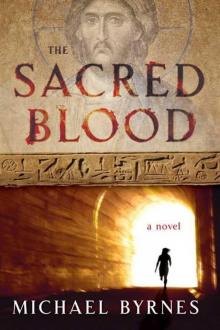 The Sacred Blood
The Sacred Blood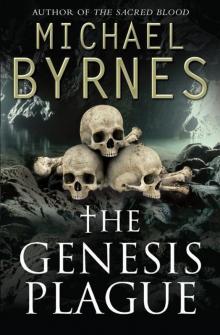 The Genesis Plague tf-1
The Genesis Plague tf-1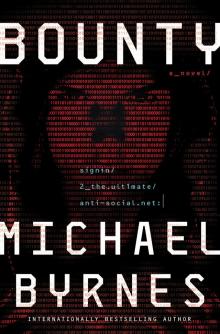 Bounty
Bounty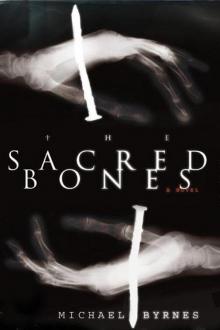 Sacred Bones : A Novel
Sacred Bones : A Novel